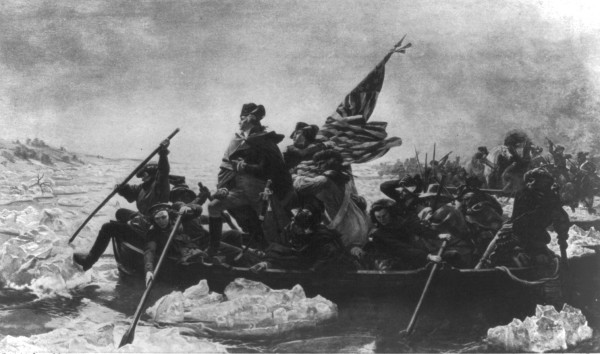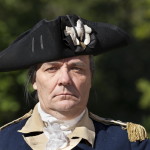
To commemorate Washington’s famous crossing of the Delaware on Christmas night 1776, we present this excerpt from Why the Turkey Didn’t Fly: The Surprising Stories Behind the Eagle, the Flag, Uncle Sam, and Other Images of America, by Paul Aron.
The most familiar image of George Washington, which has made it into everyone’s wallet, comes from Gilbert Stuart’s portrait. But though Stuart gave us Washington’s face, it was Emanuel Leutze who gave us his heroism.
Leutze’s painting Washington Crossing the Delaware portrays the night of Christmas 1776 when Washington led his beleaguered army through sleet and snow and across the icy Delaware River. The troops then marched to Trenton and surprised the Hessian mercenaries and continued to Princeton where they defeated the British.
“The image . . . is one of the folk-memories that most Americans share,” wrote David Hackett Fischer in his masterful history of the campaign (to which this essay is greatly indebted). “In our mind’s eye, we see a great river choked with ice, and a long line of little boats filled with horses, guns, and soldiers. In the foreground is the heroic figure of George Washington.”
Leutze peopled the boat with the flag-holding James Monroe and a range of American archetypes: riflemen, farmers, a seaman, a merchant, a Scottish immigrant, a black, even an androgynous figure who might be a woman. Above all, there is Washington: upright, determined, imposing. He is even more so when the painting is seen in person at New York’s Metropolitan Museum of Art: Its actual size is roughly 12 feet high and 20y feet wide.
Unlike Stuart, for whom Washington posed, Leutze did not know Washington. Leutze was not born until 1816, 17 years after Washington’s death, and Leutze did not begin work on the painting until 1848. In fact, Leutze was not even in America at the time but rather in Germany, and his intent was at least as much to inspire supporters of the European revolutions of 1848 as it was to celebrate heroes of the American Revolution of 1776. This later led the New York Times to argue that the painting represented Washington crossing the Rhine, not the Delaware.
Such criticism was unfair. Leutze had lived in America and he drew heavily on American sources, among them Thomas Sully’s 1819 painting Passage of the Delaware and a cast taken from the face of a statue of Washington by Jean-Antoine Houdon. Sully’s painting also influenced Edward Hicks, a Quaker folk artist best known for his “Peaceable Kingdom” paintings, to create his own version of Washington’s crossing.
Washington at the Delaware by Edward Hicks (1848-49). The Colonial Williamsburg Foundation.
Leutze’s efforts to make his Crossing fully American extended even to enlisting as models Americans visiting Düsseldorf. The only figure in the boat, according to Worthington Whittredge, a painter who was one of those who posed, who was not based on an American model was a Norwegian who was “acquainted with ice and accustomed to a boat and could be admitted.”
Whittredge posed both as a steersman with an oar and as Washington himself. In his autobiography, Whittredge recalled Leutze’s methods:
I stood two hours without moving, in order that the cloak of the Washington could be painted at a single sitting, thus enabling Leutze to catch the folds of the cloak as they were first arranged. Clad in Washington’s full uniform, heavy chapeau and all, spy-glass in one hand and the other on my knee, I was nearly dead when the operation was over. They poured champagne down my throat and I lived through it.
In 1850, just after Leutze finished the work, a fire in his studio caused severe damage, covering Washington and Monroe in a white haze. The painting was sufficiently restored to be displayed in the Bremen art museum until 1942, when the painting was destroyed by Royal Air Force bombing. Some, Fischer noted, saw this as Britain’s “final act of retribution for the American Revolution.”
Fortunately, soon after the fire in his studio Leutze painted another version, and it was this that made it to America in 1851. Here the artist’s attention to his American sources and his awareness of the American sensibility paid off: The painting was an immediate hit. The Bulletin of the American Art-Union described it as “one of the greatest productions of the age, and eminently worthy to commemorate the grandest event in the military life of the illustrious man whom all nations delight to honor,” and the New York Evening Mirror said it was “the grandest, most majestic, and most effective painting ever exhibited in America.” Among those who saw the painting was the young Henry James, who later described how he “gaped responsive to every item, lost in the marvel of the wintry light, of the sharpness of the ice-blocks, of the sickness of the sick soldier . . . above all, of the profiled national hero’s purpose, as might be said, of standing up, as much as possible, even indeed of doing it almost on one leg, in such difficulties, and successfully balancing.”
Washington Crossing the Delaware by George Caleb Bingham (1856-1871). Chrysler Museum of Art, Norfolk, Virginia; gift of Walter P. Chrysler Jr. in honor of Walter P. Chrysler Sr.
So successful was Leutze’s work that by the late 19th century Mark Twain, in Life on the Mississippi, commented that engravings could be found above the mantels in all the best homes along that river between St. Louis and Baton Rouge. Twain added that copies of the painting embroidered by the young ladies of those homes could be found on the walls by the doors and that these were works of art “which would have made Washington hesitate about crossing, if he could have foreseen what advantage was going to be taken of it.”
Leutze’s painting also inspired more serious artists. George Caleb Bingham’s 1871 Washington Crossing the Delaware moved the scene at least partly into his own century. Bingham placed the figures on a flatboat like those found on the Mississippi River, and he dressed many of those aboard in nineteenth-century frontier attire.
Grant Wood’s 1932 Daughters of Revolution placed three members of the Daughters of the American Revolution in front of Leutze’s painting to represent how far they had strayed from its spirit.
Larry Rivers’s 1953 Washington Crossing the Delaware, featuring an off-center Washington and an anxious soldier, fit a period when artists saw heroism as out of fashion.
Equally unheroic was Peter Saul’s 1975 Washington Crossing the Delaware, in which the general is riding his trusty steed right into the river. Also in 1975, Robert Colescott’s George Washington Carver Crossing the Delaware commented on American racism (as did, in its own way, an early twentieth-century postcard that eliminated the African American Leutze had placed on board).
Washington Crossing the Delaware by Larry Rivers (1953). The Museum of Modern Art, New York. Art (c) Estate of Larry Rivers/Licensed by VAGA, New York, New York.
Leutze’s original had plenty of historical inaccuracies of its own. The boat and uniforms were wrong for the Continental army of 1776, horses and artillery were brought over separately, the crossing actually took place at night, the ice in the river was thinner than in the painting, and the Stars and Stripes held by Monroe was not adopted until 1777.
Still, if Leutze’s image was not entirely true to the details of history, it was surely true to its spirit. The situation of Washington and his army in December 1776 was desperate. They had lost battle after battle, and many soldiers were preparing to give up and go home. Washington’s crossing and his subsequent victories at Trenton and Princeton, historian James McPherson wrote, “saved the American Revolution from collapse.” In crossing the river, Washington took a desperate gamble, and Leutze’s painting captures the significance and drama of the moment.
Guest Blogger
Paul Aron is Director of Publications for Colonial Williamsburg and the author of many entertaining reads on American history, including We Hold These Truths and Other Words that Made America and Unsolved Mysteries of America History.



Leave a Reply